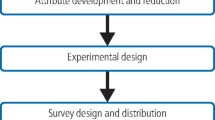Abstract
Prior to 1966, consumers purchased food items with very little (if any) nutritional labels. Now, nutritional labelling is an integral part of informed consumer choice. This paper advocates for a similar approach for healthcare-related products, using the toothbrush as an example, with the need to quantify and publish data on their clinical efficacy and environmental impact. In this paper, we consider different manufacturing models and measure the environmental impact (carbon footprint) and also the human health impact (disability-adjusted life years [DALYs]) for the most commonly used oral health product: the toothbrush.
This is a preview of subscription content, access via your institution
Access options
Subscribe to this journal
Receive 24 print issues and online access
$259.00 per year
only $10.79 per issue
Buy this article
- Purchase on Springer Link
- Instant access to full article PDF
Prices may be subject to local taxes which are calculated during checkout



Similar content being viewed by others
References
Sustainable Development Unit. Carbon footprint update for NHS in England 2015. 2016. Available online at https://www.sduhealth.org.uk/policy-strategy/reporting/nhs-carbon-footprint.aspx (accessed May 2020).
Wei Y, Wang Y, Di Q et al. Short term exposure to fine particulate matter and hospital admission risks and costs in the Medicare population: time stratified, case crossover study. BMJ 2019; DOI: 10.1136/bmj.l6258.
Peake B M, Braund R, Tong A Y C, Tremblay L A. The Life-Cycle of Pharmaceuticals in the Environment. Cambridge: Woodhead Publishing, 2016.
Debayeye S, De Soete W, De Meester S et al. Human health benefits and burdens of a pharmaceutical treatment: discussion of a conceptual integrated approach. Environ Res 2016; 144: 19-31.
World Health Organisation. Health statistics and information systems. Metrics: Disability-Adjusted Life Year (DALY). 2020. Available at https://www.who.int/healthinfo/global_burden_disease/metrics_daly/en/ (accessed May 2020).
Lyne A, Ashley P F, Saget S et al. Combining evidence based healthcare with environmental sustainability: using the toothbrush as a model. Br Dent J 2020; in press.
The Netherlands National Institute for Public Health and the Environment. LCIA: the ReCiPe model. 2018. Available at https://www.rivm.nl/en/life-cycle-assessment-lca/recipe (accessed May 2020).
Yaacob M, Worthington H V, Deacon S A et al. Powered versus manual toothbrushing for oral health. Cochrane Database Syst Rev 2014; DOI: 10.1002/14651858.CD002281.pub3.
NHS England. A Net Zero NHS. 2020. Available at https://www.england.nhs.uk/greenernhs/a-net-zero-nhs/ (accessed May 2020).
European Commission Joint Research Centre. Product Environmental Footprint Category Rules Guidance: Version 6.3. 2018. Available at https://eplca.jrc.ec.europa.eu/permalink/PEFCR_guidance_v6.3-2.pdf (accessed May 2020).
Meldrum J, Nettles-Anderson S, Heath G et al. Life cycle water use for electricity generation: a review and harmonization of literature estimates Environ Res Lett 2013; DOI: 10.1088/1748-9326/8/1/015031.
BBC News. Plastic recycling: How do bottle deposit schemes work? 2018. Available at https://www.bbc.co.uk/news/science-environment-43571269#:~:text=Research%20by%20the%20parliamentary%20Environmental,95%25%20of%20their%20plastic%20bottles.&text=It%20operates%20a%20single%20recycling,in%20every%20local%20authority%20area (accessed July 2020).
Department of Health. Delivering better oral health: an evidence-based toolkit for prevention. 2017. Available online at https://www.gov.uk/government/publications/delivering-better-oral-health-an-evidence-based-toolkit-for-prevention (accessed May 2020).
Institute of Medicine. Front-of-Package Nutrition Rating Systems and Symbols: Phase 1 Report. Washington DC: The National Academies Press, 2020.
Acknowledgements
This study was funded by the Eastman Dental Institute (University College London).
Author information
Authors and Affiliations
Corresponding author
Ethics declarations
The authors declare no conflict of interest.
Rights and permissions
About this article
Cite this article
Duane, B., Ashley, P., Saget, S. et al. Incorporating sustainability into assessment of oral health interventions. Br Dent J 229, 310–314 (2020). https://doi.org/10.1038/s41415-020-1993-9
Published:
Issue Date:
DOI: https://doi.org/10.1038/s41415-020-1993-9
This article is cited by
-
Sustainability as part of a quality framework for the organisation of oral healthcare
British Dental Journal (2023)
-
How much do consumers consider sustainability when purchasing a toothbrush? A discrete choice experiment
British Dental Journal (2022)
-
The environmental impact of community caries prevention - part 2: toothbrushing programmes
British Dental Journal (2022)



